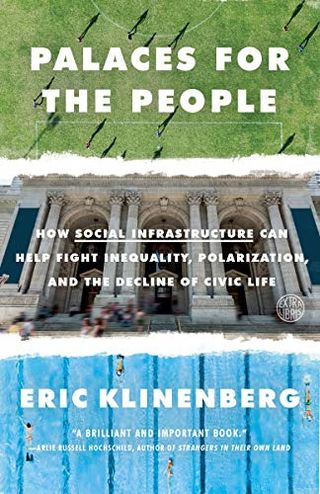Law and Crime
Palaces for the People
How better social infrastructure can enrich your life and save the world.
Posted March 1, 2020 Reviewed by Gary Drevitch

There are so many reasons for alarm and despair. Climate change is accelerating; racial inequities and injustices continue or worsen; there is a widening gap between rich and poor; and political polarization is poisoning public discourse. Children are not impervious to these concerns, and it’s comforting for both kids and their parents when a good idea comes along that can make sense on the local level, as it does on national and global levels.
Palaces for the People has a long and informative subtitle: How Social Infrastructure Can Help Fight Inequality, Polarization, and the Decline of Civic Life. Eric Klinenberg defines social infrastructure as all those places people might encounter each other: libraries, schools, playgrounds, coffee shops, parks, bookstores, town squares, community gardens, even sidewalks and train stations.
National Public Radio named Palaces for the People one of the best books of the year, and a starred review in Booklist concluded, “If America appears fractured at the national level, it can be mended at the local one.” From the New York Times: “Klinenberg shows how social infrastructure is helping to solve some of our most pressing societal challenges…Palaces for the People offers a blueprint for bridging our seemingly unbridgeable divides.”
The book opens with a compelling story of two adjacent Chicago neighborhoods that weathered a deadly 1995 heat wave in dramatically different ways. Englewood and Auburn Gresham were both 99% African American, with high rates of poverty, unemployment, and violent crime. But Englewood had 10 times more deaths during the heat wave than Auburn Gresham. Klinenberg’s investigation of this apparent anomaly led him to conclude that the key difference between these two neighborhoods was the difference in social infrastructure. Prior to the heat wave, the residents of Auburn Gresham saw each other walking to diners, parks, barbershops, and grocery stores, and participated in clubs and church groups, whereas Englewood had gradually lost its safe sidewalks and gathering places to urban decay.
Libraries are one of the most familiar examples of social infrastructure. Described by Andrew Carnegie as "palaces for the people," public libraries welcome everyone, no matter their situation. I have loved them since I was very young, and my mother took me to the local library for story hour. The books I took home and returned each week opened worlds of possibility, as they have done for so many of the people Klinenberg interviewed. Later, when my children were young, the library was a favorite place to spend time and meet other parents and young children.
Attention to social infrastructure can prevent violent crime. Employing community residents to fix up abandoned properties and create pocket parks and community gardens out of overgrown vacant lots in high-crime neighborhoods in Philadelphia, Charles Branas produced a 39% reduction in gun violence, and substantial net benefits to taxpayers. Active retail corridors—especially those that contain coffee shops—also reduce crime. Residents feel safer, and are safer, when their neighborhood is well-tended and welcoming. Klinenberg ends his chapter on “Safe Spaces” by writing, “For decades, building prisons for the poor has been our main crime reduction policy, and the social costs have been as great as the economic expense. If we want a better, more equitable, and sustainable solution for the challenges facing our cities and suburbs, we’d be better off building social infrastructure instead.”
Neighborhoods where it used to be impossible to get fresh produce at reasonable prices are becoming food destinations through the efforts of small civic organizations in Chicago. Over 800 community gardens and urban farms have been created where vacant lots and burnt-out buildings once stood. The American Public Health Association reported that the benefits of these gardens and farms go much farther than the nutritious food they produce: They reduce the temperature in overheated city centers; foster interactions across generations, resulting in less social isolation and more civic participation; reduce stress levels in community residents; and teach children about nature. Growing Home, a Chicago organization dedicated to urban farms and community development, has a program for people who’ve recently left prison, giving them jobs as production assistants, and helping them get full-time jobs when they’re finished.
Klinenberg describes research by Roger Hart and colleagues at City University of New York showing the steady erosion of outdoor play spaces, which leads to higher levels of stress and obesity, as well as reduced civic skills. Children get more than physical exercise when they play at local playgrounds and participate in team sports. They also learn about collaborative problem-solving, and how to interact with different kinds of people.
Around the world, architects and urban planners increasingly recognize the value of building social infrastructure into their designs for system upgrades and protection from the results of climate change. For example, Rotterdam has created a floating pavilion in Benthemplein Water Square that serves several simultaneous functions. It collects rainwater during heavy rains and floods, and provides a variety of public spaces during dry times as well as wet, with waterfalls, gardens, and sports facilities. This and similar projects increase resilience during emergencies, and enhance residents’ everyday lives.
Although Klinenberg makes a strong argument for inclusive social infrastructure, he makes an equally strong one against exclusive social infrastructure such as gated communities, fraternities, and border walls. These increase the inequity, mistrust, and polarization that is fracturing society.
By paying attention to social infrastructure, we can make our communities safer, more inviting, and more supportive. We can reduce crime, isolation, racism, polarization, and disconnection, and increase the chances our species will survive climate change. These are ideas to discuss with your children when they worry about the state of the world. Social infrastructure is something we can work on together, across generations.




